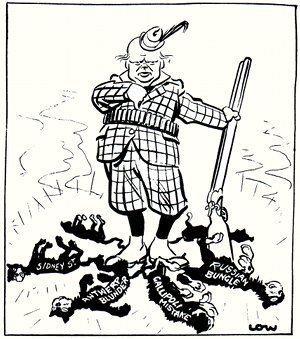W.S.C. - A Cartoon Biography
compiled by Fred Urquhart
foreword by Harold Nicolson
Cassell: London, 1955
A super-active biography in sharp cartoons
Winston S. Churchill (1874-1965) led a very long public life, famously inventive and exotic, brave and patriotic, notoriously provocative. Fred Urquhart's compilation, W.S.C. - A Cartoon Biography, provides a wonderful overview of Churchill's activities, mostly political but some personal. As he held eventually almost all the great Offices of State in the British Government, he was much in the public eye, whether seen with affection, hostility, derision, or admiration.
The first item here, a elegant caricature by Spy, shows him in 1900 at age 25, a candidate for Parliament in the Khaki Election. He was recently returned from adventures as war correspondent in the South African War, where his capture by the Boers and escape had made him a "National Figure" in Britain. And so on through more than half a century of slings and arrows, battles and laurels, to a simple cartoon of WSC as iconic British bulldog, recognizable at a glance.
So whose drawings are here, and where did they first appear? Components of the Cartoon Biography are drawn from 68 publications. They include national British newspapers and magazines: Daily Mail; Daily Mirror; Daily Worker; Daily Telegraph; Evening Standard; News Chronicle; Punch; Star; and so on. Some are further afield, for instance: Chicago Tribune; Civil & Military Gazette, Lahore; Pravda; Rand Daily Mail. And many more. Especially interesting among non-English-language publications are those of Nazi Germany before and during World War II: Simplicissimus, Der Sturmer, Volkischer Beobachter, and so on. Churchill was a particular target of Nazi propaganda, as they rightly saw him as their most unwavering foe.
80 artists are represented in the collection, many of them household names in their heyday. Most frequently shown are: Max Beerbohm, Butterworth, Gabriel, F. Carruthers Gould, Illingworth, A. W. Lloyd, Low, Poy, E. T. Reed, Strube, Vicky, George Whitelaw, Zec. The styles of course are varied, but all are clear. Several of these cartoons have long been personal favorites of mine, and I'd venture that some are graphic masterpieces of historical encapsulation.
The foreword by Harold Nicolson, himself a prominent British politician and historian and a slightly younger contemporary of Winston Churchill, is thoughtful and entertaining. Nicolson knows well the delightful history of British political caricature. He discusses, for instance, the use of symbolism to highlight and simplify portraits, and how Churchill's long public life allows us to trace the evolution of symbols not just from era to era but for a single person.
Looking back, it is easy to let our impressions be dominated by the sturdy and heroic leadership of Churchill in the Second World War. But his life was complex even in that period, and he became Prime Minister for the first time at age 65 in May 1940. We cannot appreciate his later leadership without seeing his own earlier triumphs and tragedies. Nicolson is very clear about this:

The Sidney Street episode [in 1909], when as Home Secretary he personally faced the bullets of anarchists, was not at the time viewed as a delightful manifestation of courage. It was thought unseemly. The threatened rebellion in Ulster, which he took steps to forestall or if necessary to combat, was the occasion of much animosity against him. And then, with the first war, came the Dardanelles failure [in 1915], the quarrel with Lord Fisher, and the collapse of his repute. We now know the injustice of these criticisms; the strategic plan was correct and had it been carried out with tactical vigour it might have shortened the war by two years and perhaps even have prevented the Russian revolution from taking so destructive a form. Yet the entire blame for these misfortunes was laid on Churchill's shoulders. He resigned his office and went off to fight in the trenches with the younger men.
It is salutary, if painful, to glance for a moment at the Low cartoon which appeared on January 21st, 1920 ...
["Winston's Bag: He hunts lions and brings home decayed cats."]
[The editor's note adds: The War Minister was preparing to send arms to help (newly free) Poland's attack on (newly Soviet) Russia, and the man-in-the-street became worried in case there would be another Gallipoli.]
Churchill is shown in a napoleonic pose with the dead cats of his misfortunes lying at his feet, and labelled "Gallipoli Mistake", "Antwerp Blunder", "Sidney Street", "Russian Bungle". His initiative in these matters had not been mistaken; yet for years he had to endure these imputations and for years they hampered and delayed the full fruition of his vision and strength.
Obviously the more we know about Churchill's life and British and world history of the first half of the Twentieth Century, the more we may understand and enjoy the graphic sparkles and chuckles and mudballs in W.S.C. - A Cartoon Biography. Even without knowledge of the personalities and incidents in particular cartoons, Fred Urquhart's notes on each item nicely provide bits of background and setting. With all my own lifelong reading by and about Churchill, this graphic overview always stimulates my wanting to read more.
© 2009 Robert Wilfred Franson
ArtWords at Troynovant
illustrated words, literate drawings;
cartoons, graphics, books about art
Europe at Troynovant
Europa in general
geography, peoples, culture
| Troynovant, or Renewing Troy: | New | Contents | |||
| recurrent inspiration | Recent Updates | |||
|
www.Troynovant.com |
||||
|
Reviews |
||||
| Personae | Strata | Topography |
|
|||